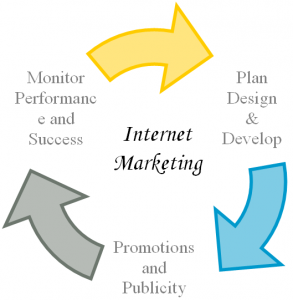Internet marketing, also known as digital marketing, web marketing, online marketing, or e-marketing, is the marketing of products or services over the Internet.
Internet marketing is sometimes considered to be broad in scope[citation needed] because it not only refers to marketing on the Internet, but also includes marketing done via e-mail and wireless media.[citation needed] Management of digital customer data and electronic customer relationship management (ECRM) systems are also often grouped together under internet marketing.
Internet marketing ties together creative and technical aspects of the Internet, including design, development, advertising, and sales. Internet marketing also refers to the placement of media along many different stages of the customer engagement cycle through search engine marketing (SEM), search engine optimization (SEO), banner ads on specific websites, email marketing, and Web 2.0 strategies. In 2008, The New York Times—working with comScore—published an initial estimate to quantify the user data collected by large Internet-based companies. Counting four types of interactions with company websites in addition to the hits from advertisements served from advertising networks, the authors found the potential for collecting data upward of 2,500 times on average per user per month.
Internet Marketing Business models
Internet marketing is associated with several business models:
- E-commerce: In this model, goods are sold directly to consumers (B2C), businesses (B2B), or from consumer to consumer.
- Lead-based Websites: A strategy whereby an organization generates value by acquiring sales leads from its website.
- Affiliate Marketing: The process in which a product or service developed by one entity (e-commerce business, single person, or a combination) is sold by other active sellers for a share of profits. The entity of the product may provide some marketing material (sales letter, affiliate link, tracking facility); however, the vast majority of affiliate marketing relationships come from e-commerce businesses that offer affiliate programs.
- Local Internet Marketing: Strategy through which a small company utilizes the Internet to find and nurture relationships that are to be used for real-world advantage. Local Internet marketing uses tools such as social media marketing, local directory listing, and targeted online sales promotions.
- White hat Marketing: This form of Internet marketing follows all of the acceptable practices for the search engines.
- Gray hat Marketing: This is when the practices are not specifically deceptive or abusive but lie in an area not specifically defined blackhat but still not entirely white hat.
- Black at Marketing: This is a form of Internet marketing that employs deceptive, abusive, or less than truthful methods
Internet Marketing and Email Marketing
E-mail marketing is a form of direct marketing which uses electronic mail as a means of communicating commercial or fund-raising messages to an audience. In its broadest sense, every e-mail sent to a potential or current customer could be considered e-mail marketing. However, the term is usually used to refer to:
- sending e-mails with the purpose of enhancing the relationship of a merchant with its current or previous customers, to encourage customer loyalty and repeat business,
- sending e-mails with the purpose of acquiring new customers or convincing current customers to purchase something immediately,
- adding advertisements to e-mails sent by other companies to their customers, and
- sending e-mails over the Internet, as e-mail did and does exist outside the Internet (e.g., network e-mail and FIDO).
Comparison to traditional mail
Advantages
E-mail marketing (on the Internet) is popular with companies for several reasons:
- An exact return on investment can be tracked (“track to basket”) and has proven to be high when done properly. E-mail marketing is often reported as second only to search marketing as the most effective online marketing tactic.
- Advertisers can reach substantial numbers of e-mail subscribers who have opted in (i.e., consented) to receive e-mail communications on subjects of interest to them.
- Over half of Internet users check or send e-mail on a typical day.
- E-mail is popular with digital marketers, rising an estimated 15% in 2009 to £292m in the UK
Disadvantages
A report issued by the e-mail services company Return Path, as of mid-2008 e-mail deliverability is still an issue for legitimate marketers. According to the report, legitimate e-mail servers averaged a delivery rate of 56%; twenty percent of the messages were rejected, and eight percent were filtered.
Companies considering the use of an e-mail marketing program must make sure that their program does not violate spam laws such as the United States’ Controlling the Assault of Non-Solicited Pornography and Marketing Act (CAN-SPAM),[6] the European Privacy and Electronic Communications Regulations 2003, or their Internet service provider’s acceptable use policy.
Legal requirements
In 2002 the European Union introduced the Directive on Privacy and Electronic Communications. Article 13 of the Directive prohibits the use of email addresses for marketing purposes. The Directive establishes the opt-in regime, where unsolicited emails may be sent only with prior agreement of the recipient.
The directive has since been incorporated into the laws of member states. In the UK it is covered under the Privacy and Electronic Communications (EC Directive) Regulations 2003 and applies to all organisations that send out marketing by some form of electronic communication.
In addition to satisfying legal requirements, e-mail service providers (ESPs) began to help customers establish and manage their own e-mail marketing campaigns. The service providers supply e-mail templates and general best practices, as well as methods for handling subscriptions and cancellations automatically. Some ESPs will provide insight/assistance with deliverability issues for major email providers. They also provide statistics pertaining to the number of messages received and opened, and whether the recipients clicked on any links within the messages.
The CAN-SPAM Act was updated with some new regulations including a no fee provision for opting out, further definition of “sender”, post office or private mail boxes count as a “valid physical postal address” and definition of “person”. These new provisions went into effect on July 7, 2008
